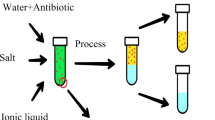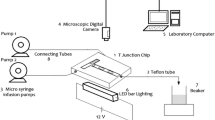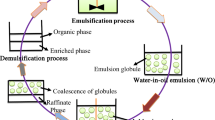Abstract
Antibiotics discharged with medical waste have had a negative impact on humans as well as aquatic organisms. Because of the severity of its effects and the frequency with which it appears in medical effluent, extraction has become obligatory. Conducting mass transfer operations in microchannels is a promising technology that has several benefits over traditional methods. In this study, the potential of performing two-phase aqueous extraction of amoxicillin in a microchannel setup was investigated. To fully comprehend the process, it was necessary to study the system's hydrodynamics and consider the variables that had the greatest influence on the extraction in the microchannel. In the hydrodynamics part, the inlet junction showed an insignificant effect on the flow pattern type while the flow rate and volume fraction had a major effect. The plug flow zone was chosen for the microchannel extraction based on its high surface area and ease of separation. Aqueous two-phase system extraction (ATPS) was conducted in a microchannel to extract amoxicillin from the aqueous phase. Three process parameters were investigated, namely temperature, salt concentration, and volume fraction, which showed a direct proportionality influence on extraction efficiency. The optimum operation conditions obtained were found to be, a temperature of 44.3 °C, a salt concentration of 42.6 wt.%, and a volume fraction of 0.45. This was accomplished in 1.96 min as compared to the 540 min reported for the conventional ATPS.











Similar content being viewed by others
References
A. Abbasi, A. Rahbar-Kelishami, Z. Seifollahi, M.J. Ghasemi, Intensified decontamination of amoxicillin drug wastewater assisted by liquid-phase micro extraction method. Environ. Technol. 43, 1551 (2022)
M. Al-Azzawi, F.S. Mjalli, A. Husain, M. Al-Dahhan, A review on the hydrodynamics of the liquid–liquid two-phase flow in the microchannels. Ind. Eng. Chem. Res. 60, 5049 (2021)
I.M. Al-Riyami, M. Ahmed, A. Al-Busaidi, B. Choudri, Antibiotics in wastewaters: a review with focus on Oman. Appl Water Sci 8, 1 (2018)
S. Al-Saidi, F.S. Mjalli, M. Al-Azzawi, B. Abutarboosh, M.A. AlSaadi, T. Al-Wahaibi, Amoxicillin removal from medical wastewater using an eco-friendly aqueous two-phase extraction system. Sep. Sci. Technol. 1, 34 (2022)
M. Alberto, Aqueous Two-Phase Systems: Properties, Functions and Advantages (Nova Science Publishers, Hauppauge, 2018)
R. Andreozzi, M. Canterino, R. Marotta, N. Paxeus, Antibiotic removal from wastewaters: the ozonation of amoxicillin. J. Hazard. Mater. 122, 243 (2005)
J.R. Dean, Extraction Methods for Environmental Analysis (Wiley, Chichester, 1998)
A.L. Grilo, M. Raquel Aires-Barros, A.M. Azevedo, Partitioning in aqueous two-phase systems: fundamentals, applications and trends. Sep. Purif. Rev. 45, 68 (2016)
M.N. Kashid, D.W. Agar, Hydrodynamics of liquid–liquid slug flow capillary microreactor: flow regimes, slug size and pressure drop. Chem. Eng. J. 131, 1 (2007)
M.N. Kashid, A. Renken, L. Kiwi-Minsker, Gas–liquid and liquid–liquid mass transfer in microstructured reactors. Chem. Eng. Sci. 66, 3876 (2011)
A.B. Kayitmazer, S.P. Strand, C. Tribet, W. Jaeger, P.L. Dubin, Effect of polyelectrolyte structure on protein−polyelectrolyte coacervates: coacervates of bovine serum albumin with poly (diallyldimethylammonium chloride) versus chitosan. Biomacromol 8, 3568 (2007)
A. Kumari, N.S. Maurya, B. Tiwari, Hospital wastewater treatment scenario around the globe. Current Developments in Biotechnology and Bioengineering (Elsevier, London, 2020), pp.549–570
Y. Liu, B. Shi, Hollow fiber supported liquid membrane for extraction of ethylbenzene and nitrobenzene from aqueous solution: a Hansen solubility parameter approach. Sep. Purif. Technol. 65, 233 (2009)
J. A. Moulijn, A. Stankiewicz, in Process intensification, eds. by V. Strezov, J. Zoeller, M. Abraham. Encyclopedia of Sustainable Technologies, vol 3. (Elsevier, London, 2017), pp. 509–518
E. Norabadi, A.H. Panahi, R. Ghanbari, A. Meshkinian, H. Kamani, S.D. Ashrafi, Optimizing the parameters of amoxicillin removal in a photocatalysis/ozonation process using box-behnken response surface methodology. Desalin. Water Treat. 192, 234 (2020)
S. Rahdar, S. Ahmadi, The removal of amoxicillin with zno nanoparticles in combination with us-H2O2 advanced oxidation processes from aqueous solutions. Iran. J. Health Sci. 7, 36 (2019)
A. Salim, M. Fourar, J. Pironon, J. Sausse, Oil-water two-phase flow in microchannels: flow patterns and pressure drop measurements. Can. J. Chem. Eng. 86, 978 (2008)
H. Santana, J. Silva, B. Aghel, J. Ortega-Casanova, Review on microfluidic device applications for fluids separation and water treatment processes. SN Appl. Sci. 2, 1 (2020)
A.A. Yagodnitsyna, A.V. Kovalev, A.V. Bilsky, Flow patterns of immiscible liquid-liquid flow in a rectangular microchannel with t-junction. Chem. Eng. J. 303, 547 (2016)
Funding
This study was funded by Sultan Qaboos University.
Author information
Authors and Affiliations
Corresponding author
Additional information
Publisher's Note
Springer Nature remains neutral with regard to jurisdictional claims in published maps and institutional affiliations.
Rights and permissions
Springer Nature or its licensor (e.g. a society or other partner) holds exclusive rights to this article under a publishing agreement with the author(s) or other rightsholder(s); author self-archiving of the accepted manuscript version of this article is solely governed by the terms of such publishing agreement and applicable law.
About this article
Cite this article
Al-Saidi, S., Mjalli, F.S., Al-Azzawi, M. et al. Aqueous Two-Phase Extraction of Amoxicillin Using Miniaturization Technology. Korean J. Chem. Eng. 41, 1399–1413 (2024). https://doi.org/10.1007/s11814-024-00061-0
Received:
Revised:
Accepted:
Published:
Issue Date:
DOI: https://doi.org/10.1007/s11814-024-00061-0




